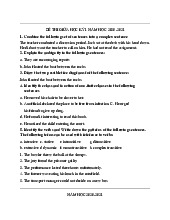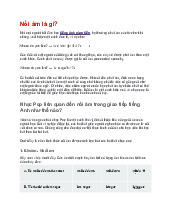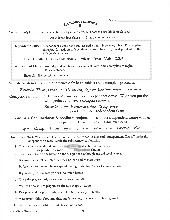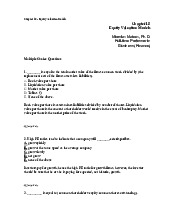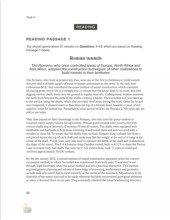



Preview text:
lOMoAR cPSD| 58797173 2 Health
Naming health problem s and treatm ents I Recognizing synonyms | Recognizing collocations Vocabulary Health problems:
• addiction (addictions)
NOUN Addiction is the condition of taking harm ful
drugs and being unable to stop taking them. ■ long-term addiction to nicotine
• allergy (allergies)
NOUN If you have a particular allergy, you become ill or
get a rash when you eat, smell, or touch something that
does not normally make people ill. ■ Food allergies can
result in an enormous variety of different symptoms. • cancer (cancers)
NOUN Cancer is a serious disease in which cells in a
person’s body increase rapidly in an uncontrolled way,
producing abnormal growths. ■a cancer research charity • dehydration
UNCOUNTABLE NOUN You are suffering from dehydration
if you lose too much water from your body. ■ Cholera
causes severe dehydration. • disease (diseases)
NOUN A disease is an illness that affects people,
animals or plants, for example one which is caused
by bacteria or infection. ■ the rapid spread of disease in the area
• infection (infections)
NOUN An infection is a disease caused by germs or
bacteria. ■ Ear infections are common in pre-school children. • obesity
UNCOUNTABLE NOUN Someone suffering from obesity is
extremely fat. ■ The excessive consumption of sugar leads to obesity • stroke (strokes)
NOUN If someone has a stroke, a blood vessel in their
brain bursts or becomes blocked, which may kill them or
make them unable to move one side of their body. ■ He
had a minor stroke in 1987, which left him partly paralyzed.
Verbs associated with treatment:
• administer (administers, administering,administered)
VERB If a doctor or nurse administers a drug, they give it
to a patient. ■ Paramedics are trained to administer
certain drugs. • admit (admits, admitting, admitted)
VERB If someone is admitted to hospital they are taken
into hospital for treatm ent and kept there until they are lOMoAR cPSD| 58797173
w ell enough to go home. ■She was admitted to hospital
with a soaring temperature.
• diagnose (diagnoses, diagnosing,diagnosed)
VERB If someone or something is diagnosed as having a
particular illness or problem, their illness or problem is
identified. ■Almost a million people are diagnosed with colon cancer each year.
• discharge (discharges, discharging,discharged)
VERB When someone is discharged from
hospital, they are officially allowed to leave, or told they
must leave. ■ He has a broken nose but may be discharged today.
• examine (examines, examining, examined)VERB If a doctor
examines you, he or she
looks at your body, feels it, or does simple Vocabulary for IELTS Unit 2
tests in order to check how healthy you are. ■Another doctor
examined her and could still find nothing wrong.
• screen (screens, screening, screened)VERB To screen for a
disease means to examine people to make sure that they do
not have it. ■ Men over 50 are routinely screened for prostate abnormalities.
• vaccinate (vaccinates, vaccinating,vaccinated)
VERB A vaccine is a harmless form of the germs that
cause a particular disease. If a person or animal is
vaccinated, they are given a vaccine, usually by
injection, to prevent them getting that disease. ■
Dogs must be vaccinated against distemper. Practice exercises
The words below describe different disorders. Circle the words that you associate with rich countries.
Underline the words you associate with poor countries.
a infection b heart e stroke f disease c allergies d dehydration g obesity addiction
Read the passage below and compare your answers to Exercise 1 with the information in the passage.
Diseases of Affluence - Diseases of Poverty
Health conditions associated with wealth are sometimes referred to as diseases of
affluence. These include diseases which are not communicable, such as Type 2 diabetes, cancer,
and stroke as w ell as alcohol and drug addiction, obesity and some allergies.
Risk factors for these conditions are associated with the lifestyle of the economically
prosperous, in particular: physical inactivity, easy availability of meat, sugar, salt and
processed foods, excessive consumption of alcohol and tobacco, and lower exposure to infectious agents.
The diseases of poverty, in contrast, are predominantly infectious diseases such as
HIV/AIDS, tuberculosis, malaria and diarrhoeal diseases. Risk factors for these conditions lOMoAR cPSD| 58797173
include: overcrowding, inadequate sanitation, malnutrition, and inadequate access to
health care. Millions of lives could be saved every year by addressing these underlying
problems and by simple preventive measures such as immunizing the population against common infectious agents.
Exam tip: In the IELTS Reading exam you may have to indicate whether statements about a
passage are True, False or Not given (i.e. not mentioned).
You can often recognize a True statement if you can match it to a part of the passage that
expresses the same idea in different words.
Recognizing synonyms (words with approximately the same meaning) can help you do this.
Example: Allergies are common in wealthy countries. Allergies are common in affluent countries.
Health 11 3 Underline words in the passage for Exercise 2 which could be replaced by the words in bold below.
1 Minor skin disorders do not norm ally require hospital treatment.
2 Misuse of prescription drugs is a growing problem.
3 Germs can cause stomach upsets.
4 Vaccinating children against measles has reduced the prevalence of this disease. 4 The words
below describe actions that medical staff may take when a person enters hospital. Number the
verbs from 1 to 5 to show the order in which they typically occur. diagnose___ discharge___ a d m it___ tre a t____ examine
Exam tip: In the IELTS Reading exam you may have to complete gaps in sentences with
words from a reading passage. Recognizing collocations (i.e. words that commonly go
together) can help you do this.
If you look carefully at the words on either side of the gap you may be able to use your knowledge of
collocations to choose the right word(s).
Example: The patient was_______for cancer. The patient was treated for cancer. Complete the
sentences below with words a-e. Look carefully at the prepositions after the gaps to help you choose
the right word. a vaccinated b diagnosed c screenedd administered e discharged
1 In poor countries patients are som etim es___________________from hospital before they are fully cured.
2 If all women over the age of 50 a re __________________ for breast cancer, many lives can be saved.
3 The patient w a s___________________with heart disease.
U A ll children should b e ___________________against infectious diseases such as measles.
5 The doctor _a drug to the patient to help him sleep. Vocabulary for IELTS Unit 2
Exam practice: Reading - answering True/False/ Not given questions - completing sentences QUESTIONS 1-4
Do the statements 7-4 below agree with the information given in the following text? Write: TRUE FALSE NOT GIVEN
if the text confirms the statement
if the text confirms the opposite of the statement
if it is impossible to know from the text Tip: Look for synonyms for key terms.
Scientists from the UK and USA have recently reported that over the last 30 years the incidence lOMoAR cPSD| 58797173
of Type 2 diabetes has more than doubled. They estimate that nearly 350 m illion adults
worldwide now have the disease. In every country studied, rates of diabetes had either remained
the same or increased. The rise has been particularly acute in the Pacific Islands with up to
thirty per cent of women in some areas suffering from the condition.
Type 2 diabetes is a chronic progressive condition which occurs when there is too much glucose
in the blood, either because the pancreas does not produce enough insulin or because cells have
become resistant to insulin. Complications resulting from diabetes include damage to
kidneys, blindness, heart disease and strokes.
The condition is associated with obesity; however, nearly three-quarters of the rise has been
attributed to longer lifespans and better diagnosis. Having a close relative with the disease is also a risk factor.
Type 2 diabetes has also become a major burden on health care systems around the world.
Expenditure on treating the condition is projected to rise to over £30 billion annually within the
next three years. However, a recent study has shown that if the condition is diagnosed within
four years of onset, it can be reversed by following a low-calorie diet. Limiting food intake to
600 calories per day for eight weeks was shown to have a lasting effect on the majority of subjects
who took part in the trial. For many, Type 2 diabetes can be cured - and it need not cost the earth.
1 More than twice as many adults have Type 2 diabetes as did thirty years ago.
2 Nearly a third of people in the Pacific Islands have diabetes.
3 Type 2 diabetes is a long-term illness which can be caused by insufficient insulin production.
4 The increase in Type 2 diabetes is partly due to greater life expectancy. QUESTIONS 5-7
Complete the sentences 5-7 using NO MORE THAN THREE WORDS from the passage above.
5 Treating diabetes places a significant on health care budgets.
6 If a person _7 Most people with diabetes early, he or she can be cured.
_ in the low-calorie diet study made a good recovery.
